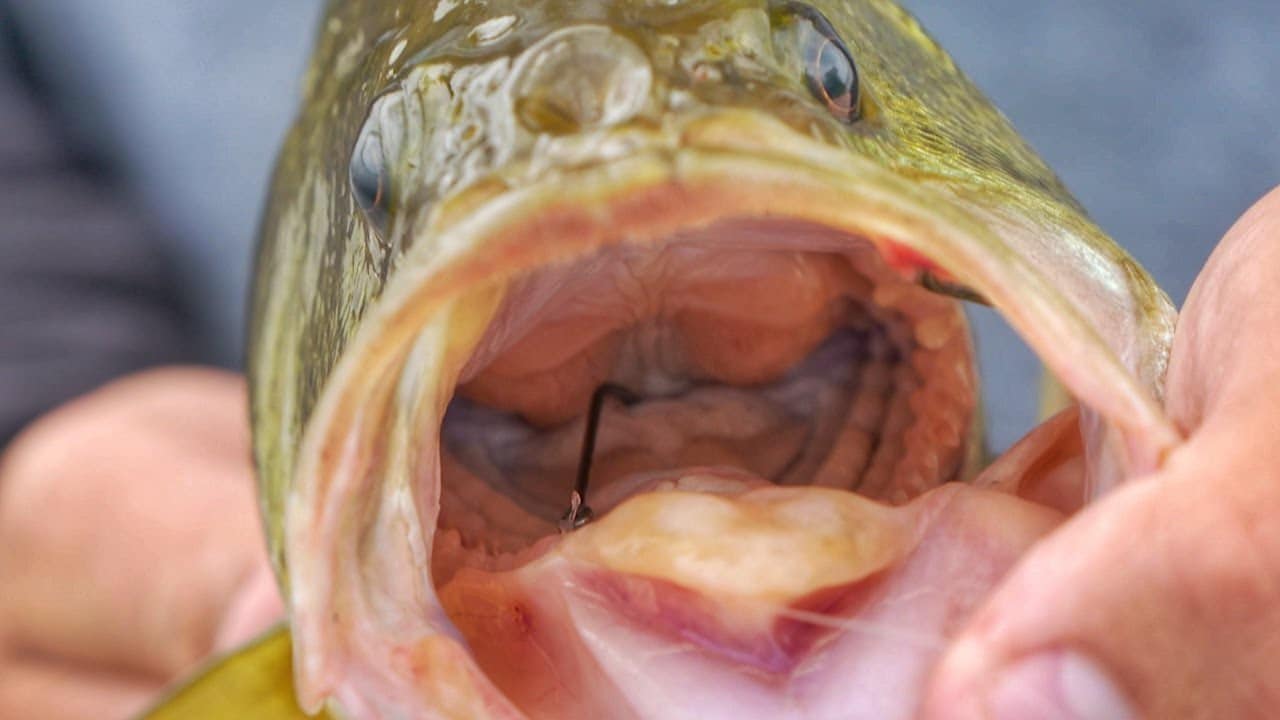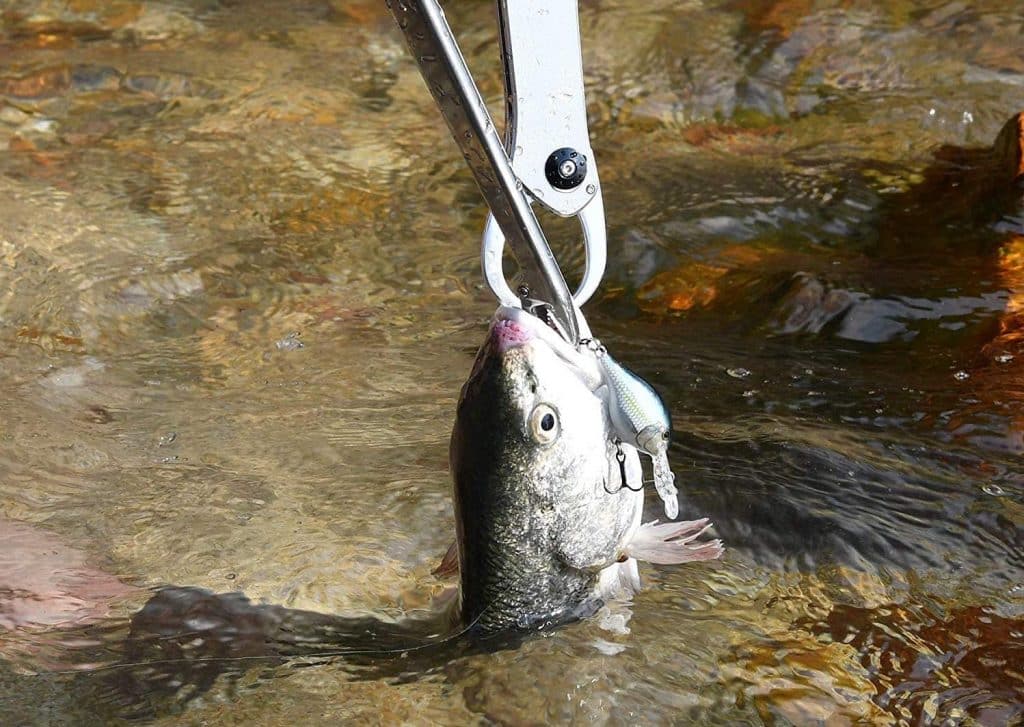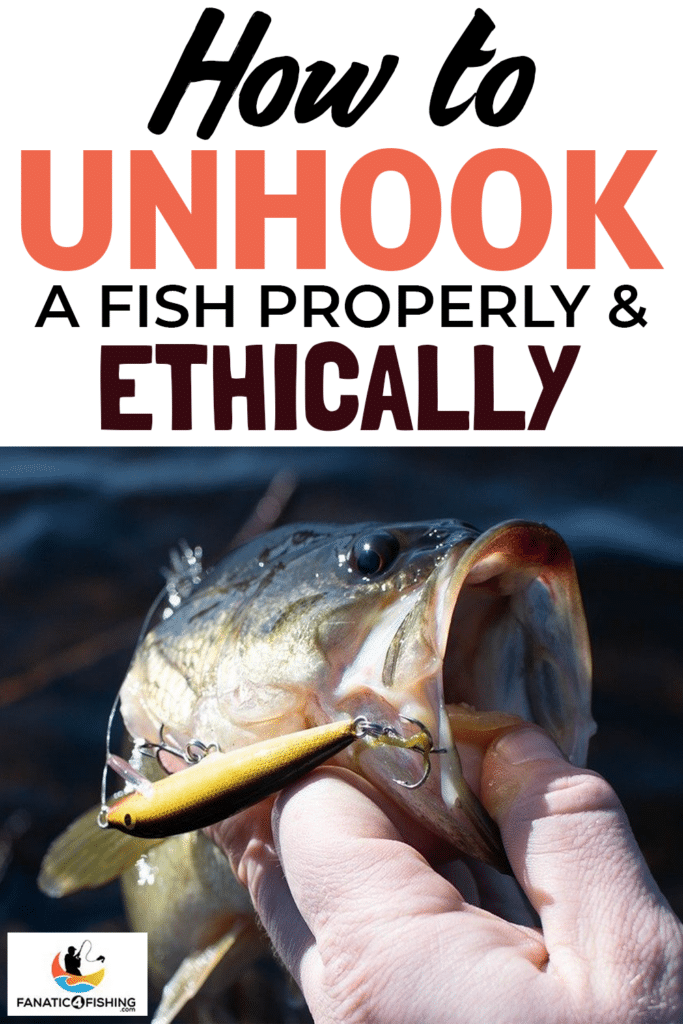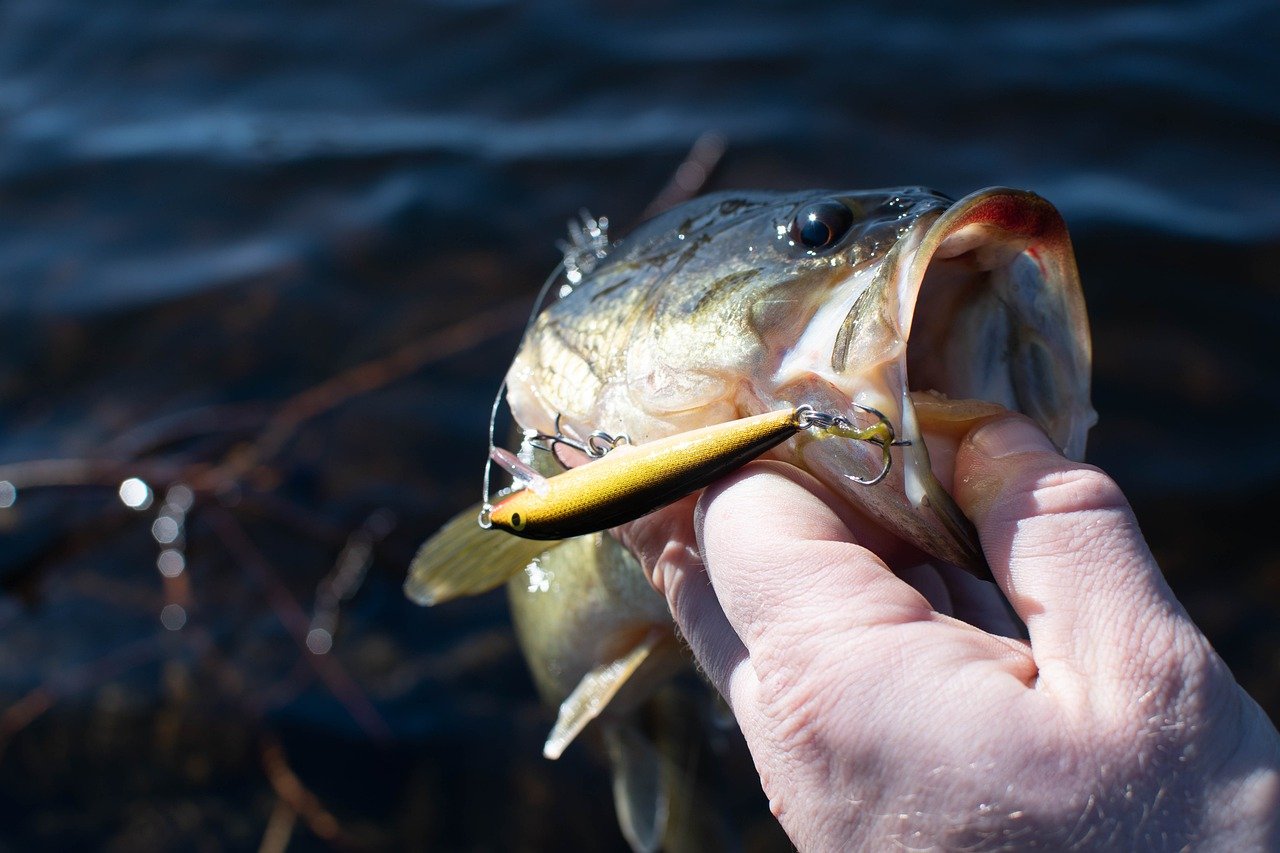Knowing what to do when it comes to unhooking a fish is one of the most important aspects of catch and release fishing. In this article, we will discuss different ways to approach safe ways to unhook a fish in different situations and allow for a successful and healthy release.
Fish Hook Location and Removal
The difficulty in unhooking a fish can vary depending on the location of the hook and the species of fish you have caught.
We can break down hook locations and decide how exactly to approach unhooking the fish. For many species, the methods will be the same for removing a fish hook. For others, it might require certain tools and methods, so we will break it down for beginner anglers.
In this section, we will take a look at removing hooks from bass, panfish, catfish, walleye, and similar species.
Lip Hooked Fish Hook Removal

This is the most common and by far the easiest location to remove a hook from a fish, it can be done by hand alone in most cases, but a pair of pliers will still come in handy at times.
For a single hook, all you need to do is get a firm grip and give it a tug, and it should come free.
When lures like crankbaits, jerkbaits, or certain topwater baits are used, it’s best to use a pair of pliers, the extra barbs and hooks can be a hooking hazard for you, and a wriggling or thrashing fish, hooks flying around, and your hand, can make for a painful experience and potentially a hospital trip.
If you are worried about hooking yourself or don’t know the steps to take if you end up hooked, be sure to check out our article on ways to remove hooks from your skin.
Deep Mouth Hooked Fish
Deeply hooked fish are a different matter entirely, and again this boils down to where exactly the fish is hooked. Is it near the gills? Did the fish swallow the hook? These are the main concerns when it comes to deeply hooked fish.
In many cases, needle nose fishing pliers will make things quick and easy. And if the hook is too deep for the long needle nose pliers to reach, a fishing hook remover is your next tool to use if the hook is accessible and not swallowed or near the gills.
How to Unhook a Fish that Swallowed the Hook

This commonly happens for fish like panfish and bass, where the fish actually swallow the hook before the angler sets the hook and retrieves the fish.
In this situation, the best thing to do is to cut your line or the hooks if they are trebles and it’s deep. While not the most ideal situation, attempting to remove the hook can cause serious damage, bleeding, and death to the fish. Fishing hooks will dissolve eventually, but this will take a long time.
Fish have very strong stomachs and are able to break down bones and spines of other fish. Eventually will eat away a hook enough for it to be passed through the fish’s system.
Fish have been caught pooping out old hooks or kept and cleaned only for the angler to find old worn down hooks which their digestive organs have grown over.
Hooked Around or in the Gills
If the fish is hooked in or around the gills, you need to proceed with extreme caution if you are releasing the fish. The Gills are the lungs of the fish and the method in which they breathe. We all know this.
This is more of an issue with treble hooks on lures like crankbaits. The triple hooks can do some serious damage if they get into the gill area.
In most cases, taking a hook cutter and gentle snipping all three points off the treble is your best option. From there, you can ever so gently, slowly, and carefully with the hands of a surgeon remove the treble hook or bait.
Pike and Musky – Unhook a Fish With Teeth

When it comes to fishing pike and musky, release tools to unhook a fish are mandatory, not an option.
Every angler should have a pair of hook cutters, medium and long needle nose pliers, jaw spreaders (the modern variety with blunt rubberized ends that don’t puncture through the roof of the mouth and bottom jaw), and a hook removal tool.
When unhooking these fish, it’s important to leave them in the water while still netted. Hence why musky anglers, in particular, have nets with very deep bags.
These fish have tons of razor-sharp teeth, so from a safety standpoint, it’s important to remember this and to keep your fingers and hands out of the fish’s mouth at all times.
Removing hooks from these species is no different than other species. The added factor is the fact that they are larger and have sharp teeth to be wary of. Hence the need for tools that can reach into their mouths safely and hook cutters to remove hooks that pose a threat to the fish.
Fish Hook Removal Tools
These tools for unhooking fish will get the job done and should be in the tackle bag or boat of every angler, regardless of species. Our picks for the best tools for removing fish hooks.
Booms Fishing R1 Stainless Steel Fish Hook Remover
- Work in saltwater and freshwater : Made by stainless steel when you going fishing whether saltwater or freshwater you can use it
- Easy to use : Spring loaded handle and 11-1/2” for one hand can remove the hooks clearly and quickly
- Save your hook : When the fish swallows your hooks and stay in deep throat it is difficult to remove the hook with a pliers ,but it works well for its slim
- Save your finger: If you practice catch and release, this hook remover can keep the fish in the water and remove the hook immediately without hurt by hooks
- Lifetime guarantee: hassle-free money back for non-artificial damage.Booms Fishing promises for 100% satisfaction to our every customer
Prices pulled from the Amazon Product Advertising API on:
Product prices and availability are accurate as of the date/time indicated and are subject to change. Any price and availability information displayed on [relevant Amazon Site(s), as applicable] at the time of purchase will apply to the purchase of this product.
This tool is easily used with one hand. It features nearly 12 inches of length to get out those deep hooks.
The tool is made of stainless steel to ward off corrosion from both fresh and saltwater fishing situations. It even features a lifetime guarantee.
Booms Fishing R2 Squeeze-out Hook Remover
It doesn’t get much easier to unhook deeply hooked fish than with this thing. Simply get the U-shaped hook on the shank of the fishing hook and release the handle, then pop the hook out.
These are really handy and are highly recommended to remove hooks from fish like bass, pike, and musky.
KastKing Speed Demon Pliers
- Key Feature – Highly corrosion resistant coated 420 stainless steel 7.5” fishing pliers and line cutters - Tungsten carbide cutters cut through mono, fluorocarbon and braid fishing line with ease – Non-slip Golf Style SuperPolymer grip - Crimp split shot or build leaders – Tune baits – Cinch knots – Cut wire - These KastKing Speed Demon Pro pliers are great as fishing tools and are handy fishing accessories to add to your fishing gear.
- 420 Stainless Steel – The KastKing Speed Demon Pro fishing pliers are made from super hard 420 stainless steel and coated with a tough coating for superior saltwater corrosion protection. Our stainless steel pliers are 46% harder than aluminum pliers and nearly 3 times the bending strength of aluminum pliers. Add this fishing tool that performs great in both freshwater and harsh saltwater environments to your fishing gear.
- Tungsten Carbide Cutter - The fishing line cutters cut though mono, fluorocarbon, or braided lines with ease. Side mounted anvil cutters for easy access. These line cutters allow you to cut your tag end as close to the knot as you want without any obstructions, and the raised surface behind the carbide blade ensures your line will always be in the cutting zone.
- Multi-Function Jaws and Hook Remover – Grab and remove any fish hook with the 2.5 inch serrated jaws or take advantage of fishing accessories like the crimping slots to secure a split shot weight or build a steel leader, and use the integrated wire cutter to trim a wire leader. To cinch down a knot quickly and safely, insert your hook into the holes in the jaws and pull your hook to create a tight knot. Integrated bait tuning slots provide a tool to adjust baits to ensure they swim correctly.
- Non-Slip Handle – The SuperPolymer handles provide comfort and control. This soft grip handle and spring loaded jaws allow for easy one hand use without worrying about your pliers slipping out of your hands. A custom molded sheath with belt clip ensures your investment is protected from normal wear and tear, and the coiled lanyard ensures your pliers don’t fall overboard! KastKing Speed Demon Pro Fishing Pliers are available in straight nose pliers and a split ring pliers nose desig
Prices pulled from the Amazon Product Advertising API on:
Product prices and availability are accurate as of the date/time indicated and are subject to change. Any price and availability information displayed on [relevant Amazon Site(s), as applicable] at the time of purchase will apply to the purchase of this product.
The KastKing Speed Demon Pro is jam-packed with tons of amazing features.
The Speed Demon is highly corrosion resistant, the pliers themselves are stainless steel. But to top that off, the pliers are also Teflon coated, giving unprecedented corrosion resistance and reliability.
They also are packed with other features like:
- Non-slip grips
- Tuning slots
- Split ring tip
- Wirecutter
- Knot cinching holes
Zerone Jaw Spreader
- 【Good quality】---Made of good quality stainless steel, unbreakable, anti-rust, durable for years of use.This tool can prevent you from biting by toothy fish, also friendly to fish
- 【Good performance】---Can help you quickly catch the fish and prevent it from escaping when getting fishing hook off.
- 【Easy to use】---keeping fish mouth open for extracting deep hooks. you can even put it into your pocket. It’s nice to have in tackle box and camping gear.
- 【Nice accessory】---Nice tools for fishing lovers.The Fish Mouth Spreader is a must for your tackle box. Makes a great gift
- 【Portable】---Portable and lightweight, easy to carry with when going out for fishi
Prices pulled from the Amazon Product Advertising API on:
Product prices and availability are accurate as of the date/time indicated and are subject to change. Any price and availability information displayed on [relevant Amazon Site(s), as applicable] at the time of purchase will apply to the purchase of this product.
This jaw spreading tool is great for fish like pike and musky.
The ends are T-shaped to help provide a solid pressure hold. As well as being rubberized, making them very safe for the fish.
How to Unhook a Fish – Conclusion
Practicing catch and release is important to ensure that future generations have the same great fishing opportunities that we enjoy today. Unhooking the fish safely and properly is one of the biggest steps in making sure the release part is successful. If you think removing a hook can be tough, check out this woman’s hook removing experiences:










